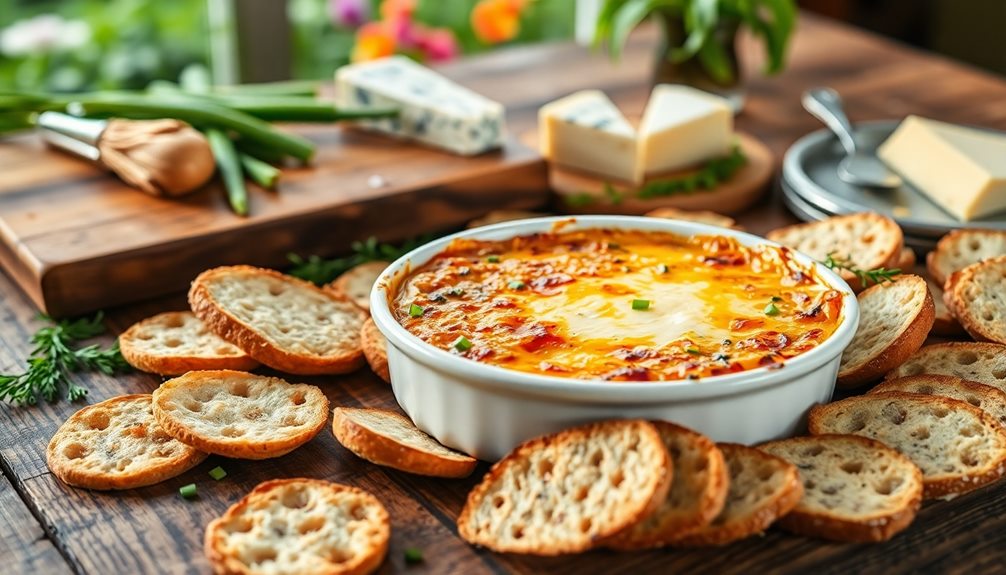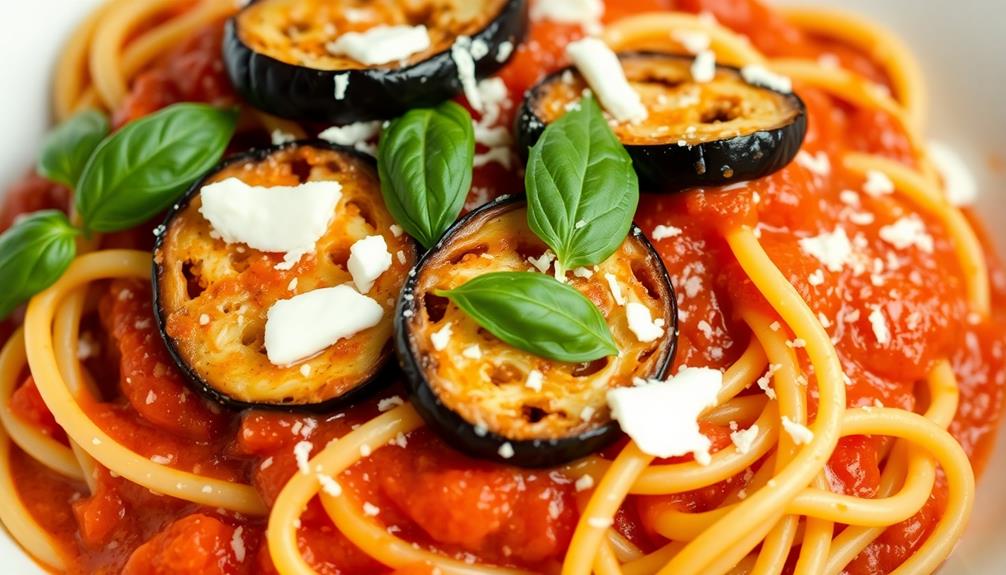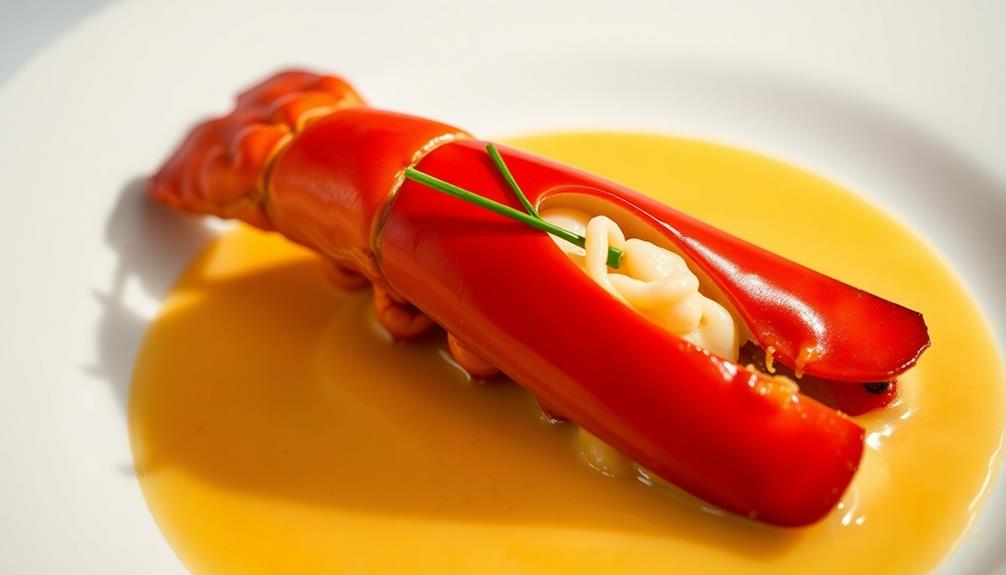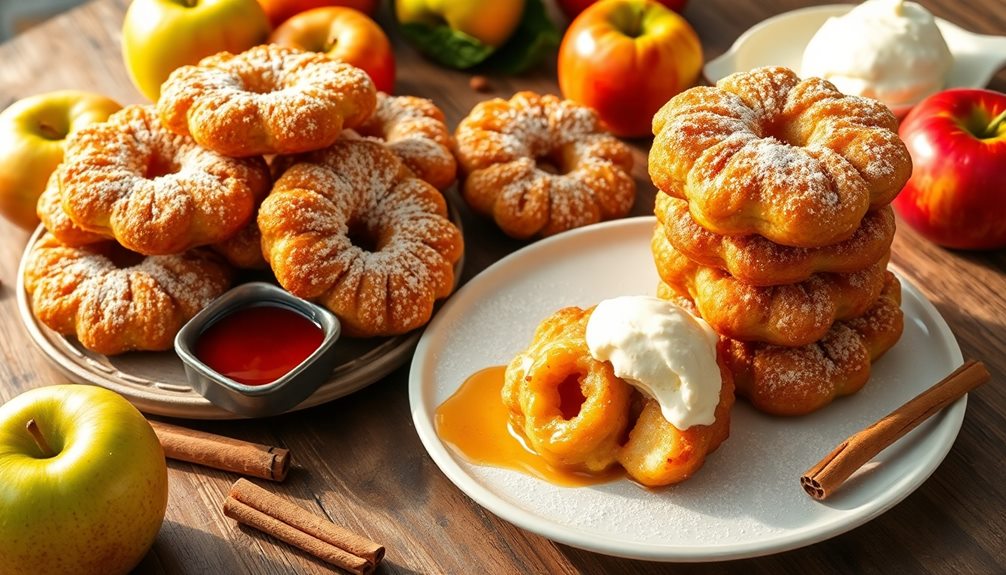Carpaccio is a mouthwatering Italian appetizer that'll transport you right to the heart of Venice! This classic dish was created at the famous Harry's Bar back in the 1950s, inspired by the vibrant paintings of Vittore Carpaccio. The secret lies in the paper-thin slices of high-quality beef or fresh seafood, drizzled with tangy lemon juice, rich olive oil, and shavings of Parmesan cheese. It's a simple yet elegant way to start any meal, whether you're hosting a fancy dinner party or enjoying a casual family gathering. Want to learn more about this culinary gem? Keep reading to uncover the full carpaccio story!
Key Takeaways
- Carpaccio is a traditional Italian dish consisting of thinly sliced raw beef, dressed with lemon juice, olive oil, and Parmesan cheese.
- The dish was reportedly created by Count Giuseppi Cipriani at Harry's Bar in Venice, named after Venetian painter Vittore Carpaccio.
- Carpaccio can also be made with seafood, vegetables, or fruit, and is enjoyed globally as a popular appetizer.
- The key to carpaccio is the thin slicing of the meat or fish, which allows the natural flavors to shine.
- Carpaccio is known for its elegant presentation, simple preparation, and balanced flavors that make it suitable for various occasions, from casual gatherings to fine dining experiences.
History
Although the origins of carpaccio can be traced back to 19th-century Italy, the dish's modern form emerged in the 1950s. Back then, Count Giuseppi Cipriani, the founder of Harry's Bar in Venice, came up with the idea of serving thin, raw beef slices dressed with lemon juice, olive oil, and Parmesan cheese. He named the dish "carpaccio" after the Venetian painter Vittore Carpaccio, whose vibrant red and white paintings inspired the colors of the dish.
Today, carpaccio is a beloved Italian appetizer enjoyed worldwide. It's often made with high-quality beef tenderloin or other lean cuts, but you can also find variations featuring seafood, vegetables, or even fruit.
No matter the ingredients, carpaccio is always thinly sliced, artfully arranged, and dressed with simple, flavorful toppings that let the main ingredient shine. It's a delightful way to start any meal, from casual gatherings to special occasions.
Recipe
Carpaccio is a classic Italian dish made from thinly sliced, raw beef or fish, typically served as an appetizer. The dish is named after the Venetian painter Vittore Carpaccio, whose paintings featured vibrant red and white tones, similar to the appearance of the dish.
The key to a successful carpaccio is the quality and freshness of the main ingredient. It's important to use the leanest and most tender cut of beef or the freshest and sushi-grade fish available.
- Beef tenderloin or sirloin
- Tuna or salmon (sushi-grade)
- Olive oil
- Lemon juice
- Parmesan cheese (optional)
- Arugula or other greens (optional)
- Salt and pepper to taste
To prepare the carpaccio, use a very sharp knife or a meat slicer to thinly slice the beef or fish. Arrange the slices in a single layer on a chilled serving plate. Drizzle with olive oil and lemon juice, and season with salt and pepper. If desired, top with shaved Parmesan cheese and a bed of fresh greens.
When preparing carpaccio, it's essential to use the freshest possible ingredients and to slice the meat or fish as thinly as possible. This ensures the dish is tender, flavorful, and visually appealing.
Carpaccio is best served immediately, as the raw nature of the dish means it can quickly lose its freshness.
Cooking Steps
Grab your sharpest knife and get ready to slice the beef into paper-thin pieces.
Drizzle the slices with rich, golden olive oil and sprinkle them generously with freshly grated Parmesan cheese.
Don't forget to add a dash of freshly ground black pepper for a little kick.
Step 1. Slice the Beef Thinly
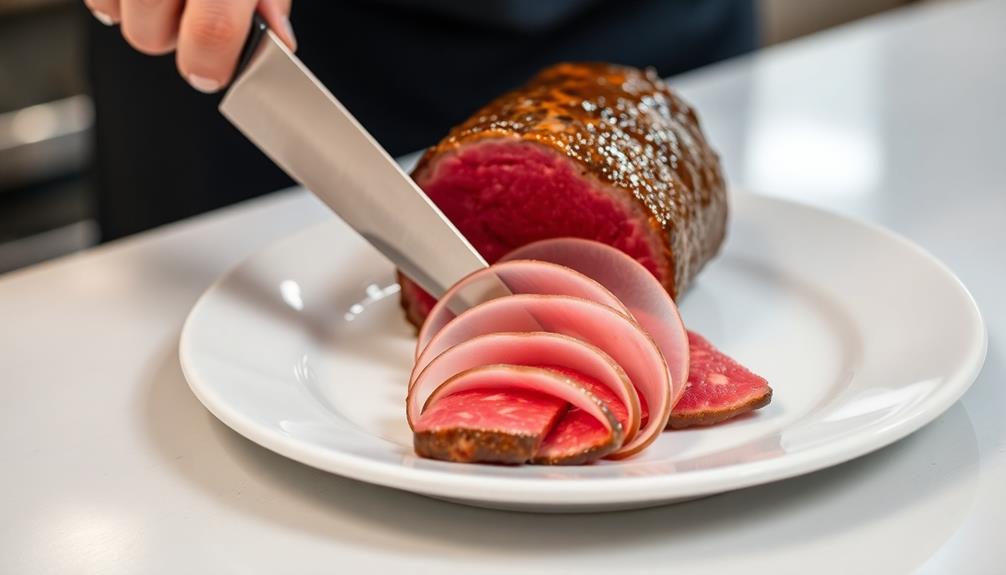
To begin, you'll want to slice the beef paper-thin. This is the key to creating that classic carpaccio texture! Use a sharp knife and take your time, gently gliding it across the chilled meat. The thinner the slices, the better – you should be able to almost see through them.
Don't worry if they're not perfectly uniform; the rustic look is part of the charm. Arrange the slices in an overlapping pattern on a serving platter, like delicate flower petals.
Now you're ready to dress up your carpaccio! Drizzle on some high-quality olive oil and scatter fresh arugula or baby greens over the top. A sprinkle of Parmesan and a squeeze of lemon juice are the perfect finishing touches.
Get ready for oohs and aahs when you bring this stunning dish to the table. Your family and friends will be impressed by your carpaccio mastery!
Step 2. Drizzle With Olive Oil

Now that you've artfully arranged the delicate beef slices, it's time to drizzle on some high-quality olive oil. This simple step adds a rich, luxurious flavor and a beautiful sheen to your carpaccio.
Grab your finest extra-virgin olive oil and hold the bottle a few inches above the plates. Slowly drizzle the oil in a circular motion, ensuring each slice is evenly coated. Don't be shy – you want to see the oil gently pooling around the edges of the beef.
Next, use the back of a spoon to lightly spread the oil over the surface, blending it with the meat. This helps the flavors meld together seamlessly.
Finally, give the plates a gentle shake to allow the oil to settle into all the nooks and crannies.
The result? A visually stunning carpaccio that glistens with fresh, fruity olive oil. Your guests will be impressed by the elegant presentation and tantalizing aromas. Enjoy this delightful dish!
Step 3. Sprinkle With Grated Parmesan Cheese

With the beef slices artfully arranged and the olive oil drizzled over, it's time to add the finishing touch – a generous sprinkle of grated Parmesan cheese. This creamy, tangy cheese will take your carpaccio to new heights!
Grab a wedge of Parmesan and grate it over the top of the dish using a fine grater. Be sure to cover every inch of the beef, creating a beautiful, cheesy blanket. The Parmesan will melt into the olive oil, creating a delightful flavor combination.
Don't be shy with the cheese – the more, the merrier! You want each bite to be bursting with the savory, nutty taste of the Parmesan. If you really love cheese, feel free to add an extra sprinkle or two. Yum!
This final step is what takes your carpaccio from ordinary to extraordinary. The grated Parmesan adds the perfect finishing touch, making this dish irresistible.
Get ready to dive in and enjoy every cheesy, beef-y bite!
Step 4. Sprinkle With Freshly Ground Pepper

After covering the carpaccio in a generous layer of grated Parmesan, the next step is to sprinkle it with freshly ground pepper. This adds a delightful burst of flavor and a touch of spice to the dish.
Use a pepper mill or grinder to crush the peppercorns right before sprinkling them over the top. Go ahead and grind it liberally – you can't have too much of that aromatic, peppery goodness! The rich flavors of the carpaccio can be complemented by a sprinkle of chia seeds for an added nutritional boost, as they're a rich source of dietary fiber that aids digestion.
The contrast between the creamy Parmesan and the sharp, pungent pepper is simply divine. It's like a party in your mouth!
Be sure to grind the pepper just before serving so its flavor is at its peak. You'll love how the pepper's warmth and subtle heat complement the rich, savory carpaccio.
With this final flourish, your carpaccio is now ready to wow your guests. Dig in and enjoy the incredible blend of flavors!
Step 5. Garnish With Fresh Arugula Leaves
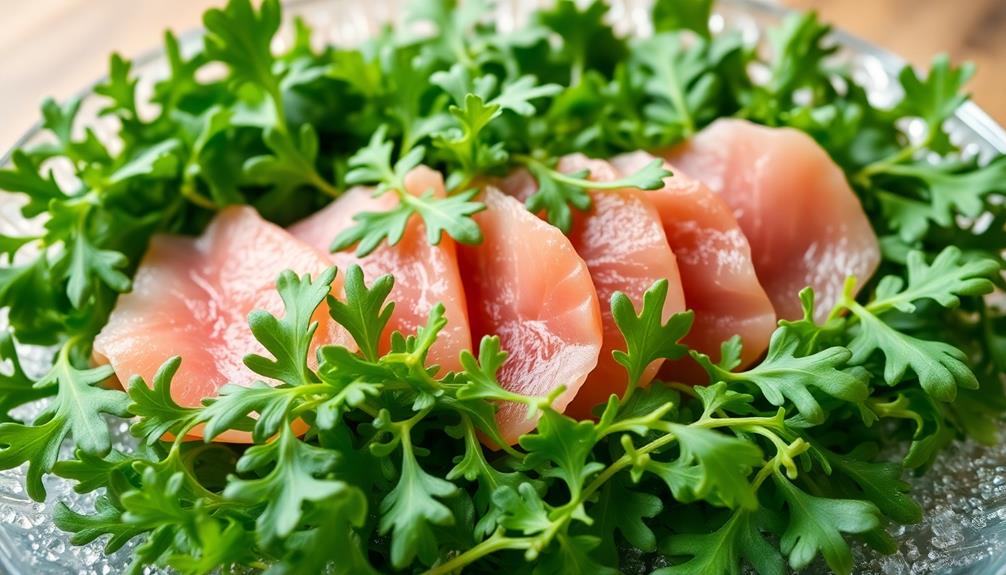
Grab a handful of fresh, peppery arugula leaves and gently place them on top of the pepper-dusted carpaccio. The bright green leaves will create a beautiful contrast against the pale, thin slices of beef. Their slightly bitter flavor will complement the richness of the meat perfectly.
Arrange the arugula leaves in an artful, overlapping pattern, allowing some of the beef to peek through. This will make your carpaccio look extra appetizing and inviting. The crisp, tender leaves will add a wonderful texture to each bite, providing a refreshing counterpoint to the tender, melt-in-your-mouth carpaccio.
Feel free to tear the larger leaves into bite-sized pieces to ensure every forkful includes a taste of the peppery arugula. This final garnish will elevate your carpaccio, transforming it into a true culinary masterpiece worthy of a special occasion or fancy dinner party.
Final Thoughts
Ultimately, the beauty of Carpaccio lies in its simplicity. This exquisite dish is a true celebration of fresh, high-quality ingredients. The paper-thin slices of raw beef, delicately arranged, allow the natural flavors to shine. The peppery arugula leaves, sprinkled over the top, add a delightful contrast in both taste and texture.
Don't be intimidated by the elegant presentation – Carpaccio is surprisingly easy to prepare at home. With just a few simple steps, you can transport your taste buds to the charming streets of Venice. Savor each bite, savoring the interplay of the tender meat, the peppery greens, and the bright lemon juice or olive oil.
Carpaccio is the perfect appetizer for any festive occasion, from a cozy family gathering to a sophisticated dinner party. Its fresh, vibrant flavors will delight and impress your guests, leaving them eager to experience this timeless Italian classic again and again. You can elevate your carpaccio experience by pairing it with crisp, toasted crostini or a light and zesty arugula salad. For a truly authentic Italian feast, consider serving carpaccio alongside a traditional Sicilian caponata recipe, filled with eggplant, tomatoes, and olives in a sweet and sour agrodolce sauce. Whether you choose to stick with the classic beef carpaccio or experiment with variations like tuna or salmon, this dish is sure to be a standout at any gathering.
Frequently Asked Questions
What Is the Origin of the Name "Carpaccio"?
You're wondering about the origin of the name "carpaccio." It's believed to have been named after the Venetian artist Vittore Carpaccio, whose paintings featured the bright red hues similar to the thinly sliced raw beef dish.
How Long Can Carpaccio Be Stored Before Serving?
You can typically store carpaccio for up to 3 days in the refrigerator before serving. It's best to consume it within this timeframe to ensure the meat stays fresh and flavorful.
Can Carpaccio Be Made With Other Types of Meat?
Yes, you can make carpaccio with other types of meat. Beef is the traditional choice, but you can also use thinly sliced fish, poultry, or even vegetables to create this delicate, raw dish.
What Is the Best Way to Slice Carpaccio Thinly?
To slice carpaccio thinly, use a sharp knife and slice the meat at an angle, gently pressing down as you move the blade. This will create thin, even slices that'll melt in your mouth.
Can Carpaccio Be Served as a Main Course or Appetizer?
You can serve carpaccio as both a main course and an appetizer. As a main, it makes for a light and refreshing meal, while as an appetizer, it's a perfect way to start a meal with its delicate flavors.



